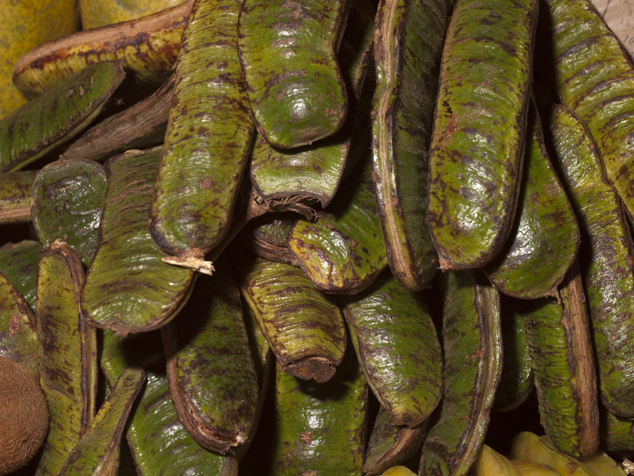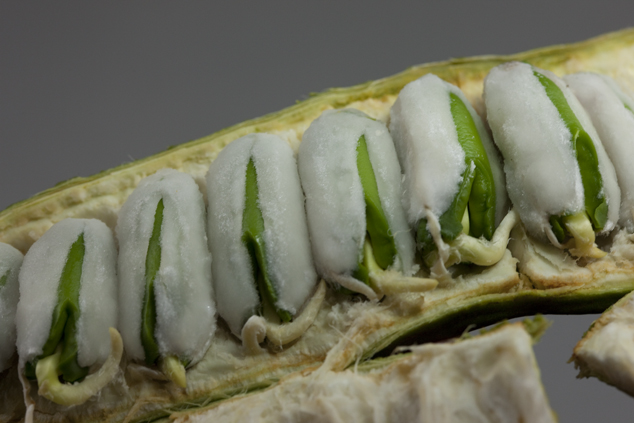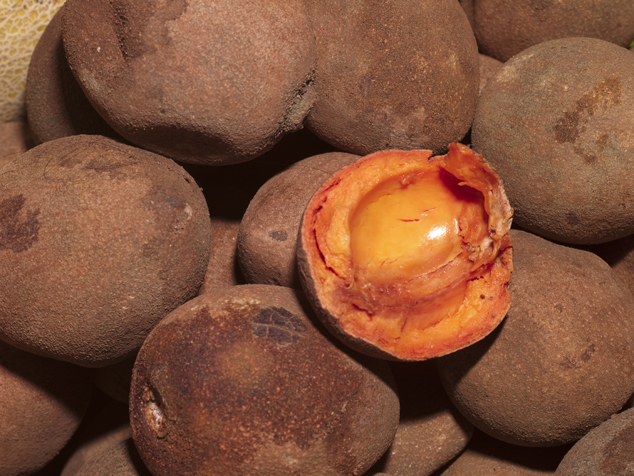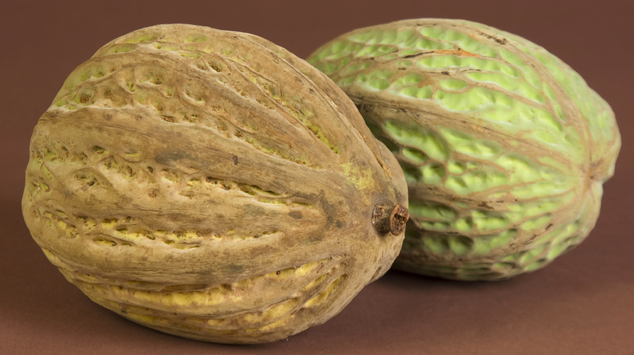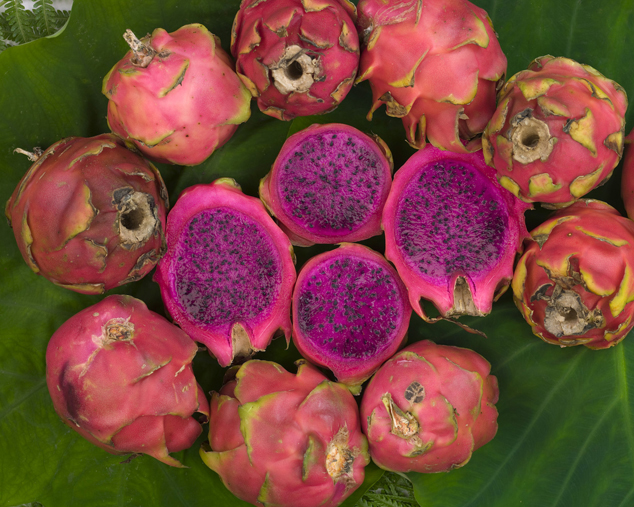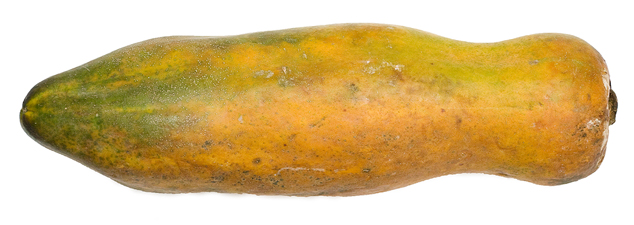Fruits and nuts have always been part of Mayan diet
Most Mayan house gardens have fruit and nut trees surrounding the homes. And in many Mayan milpas the fruit and nut trees are not cut down when the rest of the forest is slashed and burned.
So fruits, nuts, and the soft flesh of seed pods such as Inga species have been a part of Mayan diet for millennium.
Paterna, Inga paterna fruits in a local market in Guatemala
Paterna, Inga paterna fruit, notice the seed inside the fruit, the whitish and soft goo is the tasty edible part of the fruit
Most studies of Maya diet and agriculture focuses on maize, beans, squash, and root crops. So our www.maya-ethnobotany.org will have plenty of discussion of those seeds and vegetables. But we do not want to forget fruits and nuts either.
So on this page, rather than devoting an entire page exclusively to one single plant or flower, I will introduce several groups of related fruits.
Zapotes & Sapotes: yummy fruit of the Maya still raised today
Over the coming months we will introduce all the zapotes, sapotes, sapotones, zapotones, chico zapotes, mamey zapotes and everything else that has a sapote-like name.
Some are related to each other; but most have no biological relationship whatsoever. It is merely that Hispanic nomenclature dumps any fruit that has a mouse-colored brown outside, and is a tad furry, into calling it a zapote or sapote. So our goal is to introduce them all, and then discuss them in detail.
Chicozapote, Manilkara zapota fruit in a local market in Guatemala, Photo by Nicholas Hellmuth
Anona fruit; genus is named Annona (Anona is common name in Spanish)
There are almost as many different fruits named anona as there are fruits named zapote. So we are preparing a long discussion of the anona group of fruits. Their genus is Annona; in Spanish spelled simply anona.
Anona, Annona purpurea fruit, another species called with the local name anona, San Marcos, Guatemala. Photo by Jaime Leonardo, copyright FLAAR.
Cacao and relatives: fruit of the gods (and High Priest)
Cocoa is a modern mispronounciation and gringo-ized word for what should be called cacao, the plant from whose seed chocolate is made. Actually cocoa is another way of saying cacao which is a Spanish mis-prounounciation of the Aztec word which was their slightly twisted mis-pronounciation of the Mayan word cacaw(a) which was was the Maya mis-pronounciation of the word in the original language from which the name cacao came (generally conceived to be an Olmec-related or at least Mixe-Zoque languages of a thousand years before Christ).
So the word cacao is about 3000 years old, and still pronounced and spelled very similar to its original form long long ago in pre-Columbian Mesoamerica.
We will introduce relatives of cacao such as pataxte and also show other pods which look a bit like cacao but are not biologically related. FLAAR raises both cacao and pataxte in our ethnobotany institute at 1500 meters elevation.
We have dedicated many field trips throughout Guatemala to find pataxte trees, flowers, and fruits. We have also found Theobroma angustifolium.
Pataxte, Theobroma bicolor, a species relative to cacao, Photo by Jaime Leonardo, FLAAR studio, Guatemala City, Guatemala. After several years of exploration we have also found a third species of cacao. We will be reporting on this extremely rare third species as soon as funding becomes available
Passionflower fruits
Passionflowers are among the most beautiful flowers in the world. There are hundreds and hundreds of species and endless varieties. As I write this I look out at hundreds of passionflowers whose vines decorate the walls and crawl all over the roof of our 7-level office-residence in the mountains overlooking a row of volcanoes.
The world's leading botanist on passionflowers, especially of Mesoamerica, Dr. John MacDougal, is fortunately a professor in St Louis (where FLAAR has its US office). We appreciate Dr MacDougal answering our questions about passiflora of Guatemala.
Healthy Fruits from cactus or cactus-like plants
nopal and tuna, cactus, Opuntia ficus
Pitaya, Pitahaya, Hylocereus undatus. This is one of the most colorful fruits in the world. This vine-like cactus-like plant is common in the Highlands of Guatemala, though in my ethnobotany garden it often refuses to grow significantly and never flowers or does anything. It does not die: it simply never grows. I think it does not receive enough sun.
Pitaya, Hylocereus undatus open and unopen fruit, a cactus-like vine. Photo by Jaime Leonardo at FLAAR studio, Guatemala City.
Other fruits of the Mayan world that we will cover
- Avocado, Persea Américana
- "wild avocado" Persea schiedeana
- Jocote, Spondias purpurea
- nance, Byrsonima crassiflora
- papaya, Carica papaya.
- Wild papaya, Carica cauliflora, Carica mexicana
- Pineapple, a terrestrial bromeliad, Ananas comosus.
- Piñuela, Bromelia pinguin,motate
We finally found wild avocado recently (2015), either Persea gratissima or Persea schiedeana. It will take a while to understand the constantly changing names used for wild species (or wild varieties). But it is nice to have found an actual real wild Mayan avocado rather than a modern supermarket avocado (Hass Avocado).
Papaya fruit, notice the irregularly shape or this fruit. Photo by Jaime Leonardo at FLAAR studio, Guatemala City.We are also studying “wild pacaya,” which is commonly found in Alta Verapaz and El Peten and other parts of Guatemala and the rest of Mesoamerica.
And dozens and dozens more fruits that are native to southern Mexico, Guatemala, Belize, Honduras, and El Salvador: the parts of Mesoamerica inhabited by the Maya people for thousands of years.
Most recently updated February 14, 2017, because we are giving two lectures to the Rotary Club of Guatemala on healthy alternatives for children.
Previously updated August 16, 2011. And December 12, 2014 after finding many more pataxte trees, flowers, and fruits in remote parts of Guatemala. Also updated July 4, 2015, after finding many more rare fruits in remote parts of Guatemala.
First posted in late July 2011.

